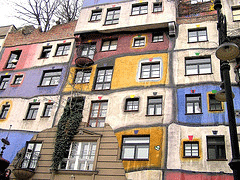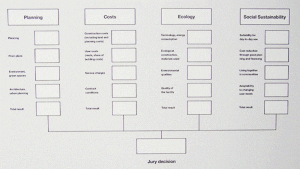
The Hundertwasser-Krawinahaus in Vienna. Photo by Ermand Akdogan via flickr, CC BY-NC 2.0
This piece in my series of articles on European cities for the Europe in Baltimore blog is on the social housing program in Vienna, which was spurred by an exhibit on the program at Baltimore’s D Center.
Vienna has a number of interesting lessons for us, each of which is deserving of deeper treatment. First, the municipal government (like Hamburg, Vienna is a city-state, which gives it more financial capital, and like Washington DC, it is the national capital, which gives it a strong economic market for revitalization, although it’s stoked by the role of the city in Europe and as a headquarters for international organizations such as the UN) is the driver of the residential real estate market.
For a variety of reasons, the majority of the city’s housing market, around 75 percent, is in rental housing. During the Socialist period from 1919 to 1934, the foundations for the city’s municipal housing production and management program were laid, and more than 60,000 units, housing more than 200,000 people, were built during that time.
After a conservative-initiated civil war (Anschluss with Germany), and World War II, this program ground to a halt, but was revived again after the end of World War II. Today, the city doesn’t directly construct new housing, but much of the housing that is produced is constructed as a result of city planning and financing. (A deeper presentation is available here: Housing in Vienna: Innovative, Social and Ecological, and one of the roundtables that helped shape the development of the presentation was written up in The Architect’s Newspaper, “Roundtable: Housing in Vienna.”)
Second, Vienna, like many European cities, is focused on building new housing at the core of the city, for sustainability and other reasons. It’s ironic that we say we’re also for that in places like D.C., but the intra-city suburbanist opposition to pro-urban changes makes that difficult to attain here.
Instead, urban sustainability planning in the U.S. has, for the most part, focused on making cities more “green” rather than more “urban,” which is counter to the points made in the book Green Metropolis, which says that the reason New York City is hyper-green is because even though the city imports water and food, it uses less energy per capita than anywhere else in the U.S. because people have smaller domiciles, use transit instead of automobiles, and buy less stuff.
I wrote about this in the context of the D.C. Sustainability Initiative more recently, “Realizing all aspects of Sustainable DC: it all comes down to chickens…,” and intend to do a follow up in the context of the arguments of Green Metropolis.
Third, to ensure that Vienna achieves the objectives in its master land use plan and housing plan, they have a detailed and rigorous planning process, including rigorous competitions for selecting developers and architects. They call this the four pillar process:
Fourth, I am struck by how social and civic infrastructure elements are integrated into the Vienna social housing development program. It’s much different from how planning is done in the U.S. There are meeting rooms, day care facilities, retail amenities, laundries, and depending on the development, even concert halls and cinemas, and a great deal of attention is focused on public spaces and the elements within them, although the creation of such infrastructure is not always easy, especially the retail, which isn’t something that nonprofit social housing agencies seem to be very good at.
I plan to discuss this general idea in the context of certain examples of revitalization planning in the U.S. soon, and in the meantime, these articles from The Guardian and The New York Times will give you an idea of the direction of the concepts.
Fifth, because Vienna borders the old “Eastern Bloc,” it is situated to be able to take advantage of European integration but is also threatened by migration from Eastern Europe, were the city to be overwhelmed and unable to integrate new populations. This is reflected in how they develop social housing, where they aim for social mixing, although they concede that it’s easier to achieve in new housing developments, where all tenants come in to the development at the outset, and more difficult to achieve in older housing developments, where housing turns over much more slowly.
It’s also reflected in how the European Union has facilitated cooperative planning by bringing Vienna together with Bratislava, the capital of Slovakia, the Czech Republic, certain counties in Hungary, and other Austrian states to focus their attention on the joint development of their combined Metropolitan Area, in an initiative called Centrope.
It’s sort of humbling to think of how difficult it is to get D.C., Maryland, and Virginia to work together (the D.C. Metro Area also includes a couple counties in West Virginia, and the combined D.C.-Baltimore Metropolitan Area includes at least one county in Pennsylvania), because the three “states” share the combined Washington Metropolitan area, whereas in Greater Vienna, it’s bringing together four different countries, and the larger Metropolitan area is named for Vienna and Bratislava.
Sixth, like how Baltimore organized its cultural planning agency, the Baltimore Office of Promotion and the Arts into a somewhat independent city agency, but with the ability to do outside funding, and with protection from meddling, Vienna’s realization of its economic development goals from support of the creative industries comes through a separately branded city agency, called Departure, although it doesn’t have the same level of independence as BOPA.
Departure is another example of a government agency executing what I call “action planning” which integrates program delivery with planning, branding, process design, and social marketing.
Then again, so is Vienna’s social housing program, which is organized through a single agency, Wohnfonds wien, the Fund for Housing Construction and Urban Renewal.
A version of this post originally ran on the Rebuilding Place in the Urban Space blog.





Comments